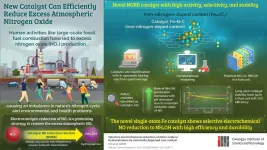Clearing the air: A reduction-based solution to nitrogen pollution with a novel catalyst
A new iron catalyst helps preferentially reduce nitric oxide to hydroxylamine, opening doors to pollution control and clean energy.
2021-05-20
(Press-News.org) Our reliance on fossil fuels as a primary energy source has pushed air pollution to an all-time high, resulting in several environmental and health concerns. Among the major pollutants, nitrogen oxide (NOx) accumulation can cause severe respiratory diseases and imbalance in the Earth's nitrogen cycle. Reducing NOx accumulation is, therefore, an issue of utmost importance.
Recently, the conversion of NOx into harmless or even useful nitrogen products has emerged as a promising strategy. Particularly appealing to scientists is the reduction of NOx to hydroxylamine (NH2OH), which can be utilized as a renewable source of energy.
The "make-or-break" step that determines the formation of hydroxylamine is the catalytic electrochemical reduction of nitric oxide (NO), which can either yield hydroxylamine or nitrous oxide (N2O), depending on the electrolyte pH and electrode potential. Studies show that for hydroxylamine formation to dominate over N2O formation, very acidic electrolytes with a pH less than 0 are required. However, such a harshly acidic environment rapidly degrades the catalyst, limiting the reaction. "The development of a new catalyst with high activity, selectivity, and stability is the next challenge," says Prof. Chang Hyuck Choi from the Gwangju Institute of Science and Technology (GIST) in Korea where he works on the catalysis of electrochemical reactions.
In a recent study published in Nature Communications, Prof. Choi and his colleagues from Korea and France investigated NO reduction in the presence of a new iron-nitrogen-doped carbon (Fe-N-C) catalyst made of isolated FeNxCy moieties bonded to a carbonaceous substrate. The catalyst was chosen for its high selectivity for the NH2OH pathway as well as its resistance to extremely acidic conditions.
The team performed in operando (i.e., during the reaction) spectroscopy and electrochemical analysis of the catalyst to determine its catalytic site and the pH dependence of NH2OH production.
They identified the active site of the catalyst as the ferrous moieties bonded to the carbon substrate where the rate of NH2OH formation showed a peculiar increase with decreasing pH. The team attributed this peculiarity to an uncertain oxidation state of NO. Finally, they achieved efficient (71%) NH2OH production in a prototypical NO-H2 fuel cell, establishing the catalyst's practical utility. Moreover, they found that the catalyst exhibited long-term stability, showing no signs of deactivation even after operating for over 50 hours!
The approach not only reduces harmful air pollutants, but also provides a useful byproduct that may find use in ushering in a renewable energy society. "Apart from the applications of hydroxylamine in the nylon industry, it can also be used as an alternative hydrogen carrier. Thus, the new catalyst will not only help reduce the amount of NOx pollutants in our atmosphere but also lead us to a renewable energy future," Prof. Choi explains.
We can breathe easy knowing that the team's findings take us a few steps closer to a pollution-free renewable energy society.
INFORMATION:
Reference
Title of original paper: Selective electrochemical reduction of nitric oxide to hydroxylamine by atomically dispersed iron catalyst
Journal: Nature Communications
DOI: https://doi.org/10.1038/s41467-021-22147-7
About Gwangju Institute of Science and Technology (GIST)
Gwangju Institute of Science and Technology (GIST) is a research-oriented university situated in Gwangju, South Korea. One of the most prestigious schools in South Korea, it was founded in 1993. The university aims to create a strong research environment to spur advancements in science and technology and to promote collaboration between foreign and domestic research programs. With its motto, "A Proud Creator of Future Science and Technology," the university has consistently received one of the highest university rankings in Korea.
Website: http://www.gist.ac.kr/
About the author
Prof. Chang Hyuck Choi is an Associate Professor in the School of Materials Science and Engineering at the Gwangju Institute of Science and Technology (GIST) in Korea. He received his B.S. (2007) and Ph.D. (2012) degrees from the Department of Chemical Engineering at the Korea Advanced Institute of Science and Technology (KAIST) in Korea. He was a postdoctoral fellow at KAIST from 2012 to 2014. From 2014 to 2016, he worked as a Humboldt Research Fellow at the Max-Planck-Institut für Eisenforschung (MPIE) in Germany. His research interests mainly focus on the fundamental principles of electrocatalysis for energy conversions.
[Attachments] See images for this press release:

ELSE PRESS RELEASES FROM THIS DATE:
2021-05-20
A large-scale research project at the University of Alaska Fairbanks Geophysical Institute has revealed insight into the relationship between surface debris on glaciers and the rate at which they melt.
The work is the first global assessment of Earth's 92,033 debris-covered glaciers and shows that debris, taken as a whole, substantially reduces glacier mass loss.
The results will affect sea level rise calculations and allow for improved assessment of hazards faced by nearby communities.
"This is the first step to enable us to start projecting how these debris-covered glaciers are going to evolve in the future and how they're going to affect glacial runoff and sea level rise," said glaciologist ...
2021-05-20
May 20, 2021 - Comets that circle the Sun in very elongated orbits spread their debris so thin along their orbit or eject it out of the solar system altogether that their meteor showers are hard to detect. From a new meteor shower survey published in the journal Icarus, researchers now report that they can detect showers from the debris in the path of comets that pass close to Earth orbit and are known to return as infrequent as once every 4,000 years.
"This creates a situational awareness for potentially hazardous comets that were last near-Earth orbit as far back as 2,000 BC," said meteor astronomer and lead author Peter Jenniskens of the SETI Institute.
Jenniskens is the ...
2021-05-20
Building more homes and buildings with wood has been on the radar for years as a way to offset carbon emissions, though construction companies have been hesitant to take the material in broader use. A study at Aalto University in Finland is now the first to show that building with wood can be a sound investment.
The team analysed statistical data from real estate sales in the Finnish capital of Helsinki and two suburbs, from 1999 to 2018. Of these, timber-built homes made up 2.23% of cases. The findings show that multi-storied buildings made out of wood sold for an average of 8.85% more than those made from other materials.
Previous research has pointed to perceptions of higher costs in wood construction, ...
2021-05-20
Biologist Sasha Mendjan at the Austrian Academy of Sciences in Vienna and his team have used human pluripotent stem cells to grow sesame-seed-sized heart models, called cardioids, that spontaneously self-organize to develop a hollow chamber without the need of experimental scaffolds. This advance, which allows for the creation of some of the most realistic heart organoids to date, appears on May 20th in the journal Cell.
Previously, scientists have built 3D cardiac organoids via tissue engineering, an approach that generally involves assembling cells and scaffolds like building a house out of brick and mortar. But these engineered organoids do not have the same physiological responses to damages as human ...
2021-05-20
Swifts aren't called "swifts" for nothing. They're known for being among the fastest migrating small birds around. When they aren't breeding, common swifts stay in the air most of the time--up to 10 months of the year. Scientists had thought they travel about 500 kilometers per day on average. Now, new evidence reported in the journal iScience on May 20 shows that's a conservative estimate.
According to new tracking data, common swifts travel 570 kilometers (more than 350 miles) on an average day--but they are capable of going much farther and faster. The maximum recorded distance in the study was more than 830 kilometers (more than 500 miles) per day over nine days.
"We have discovered that common swifts breeding in the most northern part of the European ...
2021-05-20
A common factor called "decision acuity" underpins diverse decision-making abilities in adolescents and young adults, suggests a study appearing May 20th in the journal Neuron. A large set of behavioral and neuroimaging data revealed that decision acuity is stable over time, distinct from IQ, and reduced in individuals with low general social functioning.
"We describe a new cognitive construct that captures global decision-making ability across multiple domains," says senior study author Raymond Dolan of University College London. "This construct may be important for understanding mental health, particularly regarding poor social function and aberrant thought patterns."
Decision-making is ...
2021-05-20
DALLAS, May 20, 2021 — While death rates from cardiovascular disease (CVD) nationwide have steadily declined over the past few decades, the overall trend masks significant disparities between high- and low-mortality counties, according to preliminary research to be presented at the American Heart Association’s Epidemiology, Prevention, Lifestyle & Cardiometabolic Health Conference 2021. The meeting is virtual, May 20-21, and offers the latest science on population-based health and wellness and implications for lifestyle.
The researchers examined mortality data from the National Center for Health Statistics collected from 1980 to 2014 from all 3,133 ...
2021-05-20
DALLAS, May 20, 2021 — Women who are menopausal by the age of 40 had a 40% increased risk of developing coronary heart disease over their lifetime compared to women who did not go through early menopause, according to preliminary research to be presented at the American Heart Association’s Epidemiology, Prevention, Lifestyle & Cardiometabolic Health Conference 2021. The meeting is virtual, May 20-21 and offers the latest science on population-based health and wellness and implications for lifestyle.
Coronary heart disease is a very common type of heart disease in which arteries around the heart become blocked due to a buildup of plaque, which develops over time. Left undetected and untreated, women can suffer ...
2021-05-20
DALLAS, May 20, 2021 — Taking more steps per day, either all at once or in shorter spurts, may help you live longer, according to preliminary research to be presented at the American Heart Association’s Epidemiology, Prevention, Lifestyle & Cardiometabolic Health Conference 2021. The meeting is virtual, May 20-21, and offers the latest science on population-based health and wellness and implications for lifestyle.
Walking is one of the safest and easiest ways to improve fitness and health including heart health. The American Heart Association’s fitness guidelines for adults recommend at least 150 minutes per week of moderate or 75 minutes of vigorous physical activity, or a combination of both. Popular fitness ...
2021-05-20
DALLAS, May 20, 2021 — Black adults in the U.S. who consumed significant amounts of ultra-processed foods were at 55% increased risk for high blood pressure compared to white adults who ate a similar amount of ultra-processed foods, according to according to preliminary research to be presented at the American Heart Association’s Epidemiology, Prevention, Lifestyle & Cardiometabolic Health Conference 2021. The meeting is virtual, May 20-21 and offers the latest science on population-based health and wellness and implications for lifestyle.
Ultra-processed foods (UPF) are ready-to-eat formulations of industrially formulated products, ...
LAST 30 PRESS RELEASES:
[Press-News.org] Clearing the air: A reduction-based solution to nitrogen pollution with a novel catalyst
A new iron catalyst helps preferentially reduce nitric oxide to hydroxylamine, opening doors to pollution control and clean energy.




